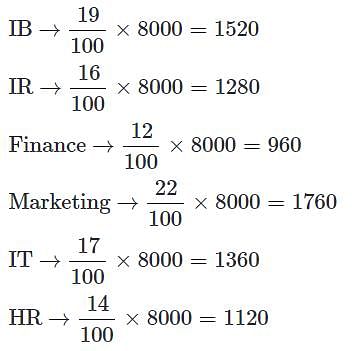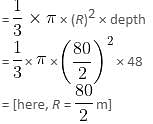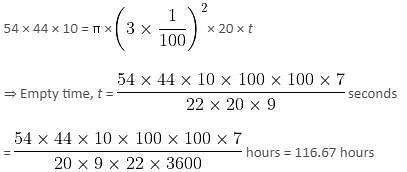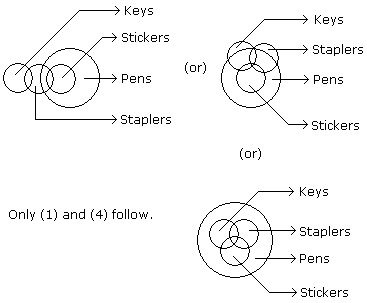SSC CGL (Tier II) Practice Test - 22 - SSC CGL MCQ
30 Questions MCQ Test - SSC CGL (Tier II) Practice Test - 22
Direction: Study the pie-chart given below carefully and answer the questions that follow.
Percentage-wise break up of students in terms of specialization in M.B.A.
Total Number of students = 8000.

Q. What is the total number of students having IB as specialisation?
Percentage-wise break up of students in terms of specialization in M.B.A.
Total Number of students = 8000.

Find the approximate time taken to fill a chemical conical vessel, if the flow rate is 20 meters per minute from a cylindrical pipe whose diameter is 5 meters. Take diameter and depth of the conical vessel as 80 meters and 48 meters, respectively.
A rectangular reservoir has dimensions 54 meters × 44 meters × 10 meters. An outlet pipe of circular cross-section has a radius of 3 centimeters and the water runs through the pipe at a rate of 20 meters/second. What is the time taken by the outlet pipe to empty the reservoir full of water?
Directions to Solve: In each of the questions below consists of a question and two statements numbered I and II given below it. You have to decide whether the data provided in the statements are sufficient to answer the question. Read both the statements and
Give answer:
- (A) If the data in statement I alone are sufficient to answer the question, while the data in statement II alone are not sufficient to answer the question
- (B) If the data in statement II alone are sufficient to answer the question, while the data in statement I alone are not sufficient to answer the question
- (C) If the data either in statement I alone or in statement II alone are sufficient to answer the question
- (D) If the data given in both statements I and II together are not sufficient to answer the question and
- (E) If the data in both statements I and II together are necessary to answer the question.
Question: How is Sulekha related to Nandini ?
Statements:
I.Sulekha's husband is the only son of Nandini's mother.
II.Sulekha's brother and Nandini's husband are cousins.
If P + Q means P is the brother of Q; P x Q means P is the wife of Q and P % Q means P is the daughter of Q then which of the following means D is the uncle of A?
Directions to Solve
In each of the following questions there are three statements. Which are followed by three or four conclusions. Choose the conclusions which logically follow from the given statements.
Question -
Statements: Some keys are staplers. Some staplers are stickers. All the stickers are pens.
Conclusions:
- Some pens are staplers.
- Some stickers are keys.
- No sticker is key.
- Some staplers are keys.
Directions to Solve
In each of the following questions there are three statements. Which are followed by three or four conclusions. Choose the conclusions which logically follow from the given statements.
Question -
Statements: All the locks are keys. All the keys are bats. Some watches are bats.
Conclusions:
- Some bats are locks.
- Some watches are keys.
- All the keys are locks.
If X + Y means X is the daughter of Y; X - Y means X is the brother of Y; X % Y means X is the father of Y and X x Y means X is the sister of Y. Which of the following means I is the niece of J?
Below a paragraph has been given with some words highlighted in it which may or may not be contextually correct. You are required to replace these words with the most suitable word from the given options in order to form a meaningful and coherent paragraph.
On New Year’s eve, nine hours before a new GST rate of 12% was to kick out for readymade garments and fabrics, Finance Minister Nirmala Sitharaman announced that the plan is off and the existing 5% rate will continue into 2022, or at least for its first quarter. The decision was made at an emergency meeting of the GST Council, which had disregarded the higher tax on textiles at its last meeting in September 2021 to correct the consistency of an inverted duty structure. While the GST rate on man made fibre is 18% and yarn made from the same is taxed at 12%, the rate on the final fabric was 5%, awfully creating a headache for textile producers which the Council had sought to aggravate. The move to raise that rate to 12%, along with that on footwear costing less than Rs.1,000 a pair, had been on the Council’s agenda for over a year but had been kept on hold due to the COVID-19 pandemic’s adverse effects on households.
Q. Which of the following words will replace the highlighted word “awfully”?
Directions: Read the passage given below and answer the questions that follow by choosing the correct/most appropriate options:
The newspaper rule of thumb is that ‘dog-bites-man’ stories are not newsworthy. However, with a nearly 1.5 crores stray dog population (2019 livestock census), and a dubious distinction of being the world’s dog-bite-and-rabies-capital, India’s ‘stray dog menace’ has a steady presence in the media ecosystem, to the point of being anaesthetising. Occasionally, this stupor is broken by the macabre. An infant in a Rajasthan hospital was reportedly taken away by stray dogs, while strays attacked a four-year-old, with fatal results, which were captured by CCTV cameras, in Telangana. Both incidents constitute only a fraction of the many dog attacks. Despite the acknowledgment of the crisis by States, the Centre, the judiciary, municipalities, and non-governmental organizations, the problem festers.
Dogs have a unique relationship with man’s evolutionary history — one of companionship. This poses a moral dilemma of being responsible for their welfare but also confronting the vagaries of their evolution from wolves and their territorial instincts. While by no means a conundrum unique to India, much of the world has drawn the line by de-recognizing the rights of stray animals: if leashed and registered, human custodians are obliged to take care of them. If not, the state — as a last resort — is encumbered to euthanize them, in the interest of public health. The Prevention of Cruelty to Animals (PCA) Act and the Animal Birth Control (Dogs) Rules, 2001 (being updated), while aimed at limiting the stray population, do nothing to improve public safety. The proposed draft rules, or the Animal Birth Control Rules, 2022, only put forth procedural changes in sterilization and vaccination, permit only “incurably ill and mortally wounded” dogs to be euthanized, which is what existing rules permit, and make leaders of resident welfare associations responsible for feeding strays in pockets. The PCA and ABC rules acknowledge that unchecked strays must be restrained. However, they do not factor in the magnitude of the problem: that there is nearly one stray for every 100 Indians; that India lacks the infrastructure and mechanism to ensure that the most vulnerable (the poor and their children) are able to access treatment and that expecting dog numbers to reduce on their own with sterilization and vaccination is a pipe dream. India has committed to eliminating rabies by 2030, but without first framing the threat from stray dogs as a public health crisis, India’s poorest will continue to see their right to safe public spaces culled at the altar of callous activism.
Q. Choose the antonym of the word 'Fatal'.
Directions: Read the passage given below and answer the questions that follow by choosing the correct/most appropriate options:
The newspaper rule of thumb is that ‘dog-bites-man’ stories are not newsworthy. However, with a nearly 1.5 crores stray dog population (2019 livestock census), and a dubious distinction of being the world’s dog-bite-and-rabies-capital, India’s ‘stray dog menace’ has a steady presence in the media ecosystem, to the point of being anaesthetising. Occasionally, this stupor is broken by the macabre. An infant in a Rajasthan hospital was reportedly taken away by stray dogs, while strays attacked a four-year-old, with fatal results, which were captured by CCTV cameras, in Telangana. Both incidents constitute only a fraction of the many dog attacks. Despite the acknowledgment of the crisis by States, the Centre, the judiciary, municipalities, and non-governmental organizations, the problem festers.
Dogs have a unique relationship with man’s evolutionary history — one of companionship. This poses a moral dilemma of being responsible for their welfare but also confronting the vagaries of their evolution from wolves and their territorial instincts. While by no means a conundrum unique to India, much of the world has drawn the line by de-recognizing the rights of stray animals: if leashed and registered, human custodians are obliged to take care of them. If not, the state — as a last resort — is encumbered to euthanize them, in the interest of public health. The Prevention of Cruelty to Animals (PCA) Act and the Animal Birth Control (Dogs) Rules, 2001 (being updated), while aimed at limiting the stray population, do nothing to improve public safety. The proposed draft rules, or the Animal Birth Control Rules, 2022, only put forth procedural changes in sterilization and vaccination, permit only “incurably ill and mortally wounded” dogs to be euthanized, which is what existing rules permit, and make leaders of resident welfare associations responsible for feeding strays in pockets. The PCA and ABC rules acknowledge that unchecked strays must be restrained. However, they do not factor in the magnitude of the problem: that there is nearly one stray for every 100 Indians; that India lacks the infrastructure and mechanism to ensure that the most vulnerable (the poor and their children) are able to access treatment and that expecting dog numbers to reduce on their own with sterilization and vaccination is a pipe dream. India has committed to eliminating rabies by 2030, but without first framing the threat from stray dogs as a public health crisis, India’s poorest will continue to see their right to safe public spaces culled at the altar of callous activism.
Q. Which of the following is/are correct according to the given passage?
A. The newspaper rule of thumb is that ‘dog-bites-man’ stories are significant.
B. India’s stray dog menace has a steady presence in the media ecosystem.
C. An infant in a Haryana hospital was reportedly taken away by stray dogs.
Directions: In the following passage, some words have been deleted. Select the most appropriate option to fill in each blank.
Italy, a country of south-central Europe, ________(1) a peninsula that juts deep into the Mediterranean Sea. Italy ________ (2) some of the most varied and scenic landscapes on Earth and is often described as a country shaped like a boot. At its broad top stand the Alps, which are among the world’s most rugged mountains. Italy’s highest points are along Monte Rosa, which peaks in Switzerland, and along Mont Blanc, which peaks in France. The western Alps ______ (3)a landscape of Alpine lakes and glacier-carved valleys that stretch down to the Po River and Piedmont. Tuscany, to the south of the cisalpine region, is perhaps the country’s best-known region. From the central Alps, running down the length of the country, _________ (4) the tall Apennine Range, which widens near Rome to cover nearly the entire width of the Italian peninsula. South of Rome the Apennines narrow and are ________(5) by two wide coastal plains, one facing the Tyrrhenian Sea and the other the Adriatic Sea.
Q. Select the most appropriate option to fill in the blank (1)
Directions: In the following passage, some words have been deleted. Select the most appropriate option to fill in each blank.
Italy, a country of south-central Europe, ________(1) a peninsula that juts deep into the Mediterranean Sea. Italy ________ (2) some of the most varied and scenic landscapes on Earth and is often described as a country shaped like a boot. At its broad top stand the Alps, which are among the world’s most rugged mountains. Italy’s highest points are along Monte Rosa, which peaks in Switzerland, and along Mont Blanc, which peaks in France. The western Alps ______ (3)a landscape of Alpine lakes and glacier-carved valleys that stretch down to the Po River and Piedmont. Tuscany, to the south of the cisalpine region, is perhaps the country’s best-known region. From the central Alps, running down the length of the country, _________ (4) the tall Apennine Range, which widens near Rome to cover nearly the entire width of the Italian peninsula. South of Rome the Apennines narrow and are ________(5) by two wide coastal plains, one facing the Tyrrhenian Sea and the other the Adriatic Sea.
Q. Select the most appropriate option to fill in the blank (5)
Directions: The given sentence has been broken into four parts. The error, if any, will be in one part of the sentence. Select the option which contains the error-less combination. If all are correct, mark Option 5 as your answer.
Q. Emile Durkheim, the first person to be formally(A)/ recognized as a sociologist and the most(B)/ scientific of the pioneers, conducted a study (C)/ that stand as a research model for sociologists today. (D)/ No error(E)
Rearrange the following five sentences (A), (B), (C), (D) and (E) in the proper sequence to form a meaningful paragraph then answer the questions given below them.
A. The government is reportedly contemplating imposing similar licensing requirements on imports of products such as furniture, toys and sports goods.
B. Ostensibly, these measures — in line with the government’s stated policy of “atma nirbharta” or self reliance — are meant to reduce the country’s import dependence
C. Importers will now require a licence from the government to import fully built television sets into the country.
D. The option of raising duties on imports of certain products is, reportedly, also under consideration.
E. Last week, the Union government imposed restrictions on television imports, much of which are sourced from Vietnam and China, by placing them in the restricted category.
Q. Which of these is FOURTH sentence after rearrangement?
Directions: In this question, a sentence has been divided into five parts (A), (B), (C), (D), and (E). Read the sentence to find out whether there is any grammatical error in it. The error if any, will be in one part of the sentence. If there is no error, the answer is 'No error'. Ignore the error of punctuation if any.
Q. People living besides railway stations (A)/ have to put up with (B)/ a lot of noise (C)/ from engines, horns, and whistles. (D)/ No error (E)
Directions: Read the passage given below and answer the questions that follow by choosing the correct/most appropriate options:
An aggravating factor, often overlooked, is the shape that inequality takes in different segments _____ our society. It is economic on one plane; on others, it is regional, caste, and religious. Some are spelt out, others understated, and still others assumed. Sociologists have identified nine categories of people who are determined to be socially and/or politically and/or economically excluded. These particularly include Dalits, Adivasis, women, and religious minorities. Recent studies on religious minorities who constitute around 20% of India’s population have traced discrimination relating to them to perceptions that relate to the very origins of thinking that brought about the partition of August 1947. They argue that violence was not merely accidental but integral to the foundation of the nation and that the need for fraternity coexisted with the imperative need for restoring social cohesion in segments of society.
Much blame for the haste displayed by decision-makers has been written about on the basis of the documentation made available subsequently and, at this distance of time, its validity cannot be dismissed altogether. A primary concern of the Constitution-makers related to cohesion and integration of the units of the new Republic formally described as ‘A Union of States’. In the words of Sardar Vallabhbhai Patel, ‘the inspiration and the stimulus came from above rather than from below and unless the transplanted growth takes a healthy root in the soil, there will be a danger of collapse and chaos.’ This was amplified by V.P. Menon as the integration ‘of the minds of the people’. Over time, uneven development has characterized the States of the Indian Union. Regional and linguistic diversity characterizes them. And so does uneven economic development and progress, resulting in uneven levels of education, employment, social cohesion, and contentment.
Q. Which of the following is/are correct according to the given passage?
A. Religious minorities constitute around twenty percent of India’s population.
B. Five categories of people are determined to be economically excluded.
C. Uneven development has not characterized the States of the Indian Union.
A passage has been given below. Few words and sentences have been highlighted to help you answer some of the questions. Read the same carefully and answer the questions that follow:
Ideas and actions rarely get wind together to end decades-old social inequities. Visions can become virtuies if they are accompanied by a determination to create an equitable society. Three years ago, Prime Minister Narendra Modi decided to offload the past that was holding back the 1.3 crore citizens of Jammu and Kashmir from realizing their potential. He rolled out the process to build a new and vibrant Union Territory. Jammu and Kashmir, since then, is walking the PM’s talk and has travelled quite a distance to re-arrange priorities of development, initiate deep reforms in governance, curb corruption, and realise the dreams of youth. In this Amrit Kaal, we are the new destination, not just for tourists but for businesses as well.
In 2018-19, only 9,229 projects were completed in a year. This has increased to 50,627 in the financial year 2021-22. Rs 1 lakh crore is being spent to improve road connectivity and build tunnels. Social sector spending has increased by 43.83 per cent and the economic sector by 45.60 per cent in the last three years.
More than 200 public services have been made available online to receive real-time feedback from citizens. Providing houses to people in rural areas, developing roads, putting in place primary health facilities and safe drinking water services, creating more avenues for education, employment, and agriculture, attracting private investment and bridging gaps between government delivery mechanisms and people’s expectations were some of the tasks we completed by building trust between the administration and the people. Structural and institutional changes like ending the 150-year-old Darbar Move brought in another layer of transparency and improvement in governance. It also saved about Rs 400 crore annual expenditure that used to be incurred in shifting logistics from Srinagar to Jammu and back. It has also prevented the loss of at least one working month every year.
Projects worth Rs 58,477 crore under the Prime Minister’s Development Package have picked up pace and direction after impediments and bottlenecks that _________ (a) growth — land acquisition, forest clearances, utility shifting and court cases — were removed. Dreams and aspirations are ________________ (b)of the common man in J&K, which has encouraged us to work harder.
Q. Which of the following tasks has not been completed in order to build trust between the administration and the people?
Consider the following statements about the formation of Tropical Cyclones.
1. There should be continuous supply of abundant dry and cold airmass.
2. Higher value of Coriolis force is required for the origin of these cyclones.
3. They are associated with the inter-tropical convergence (ITC) which extends from 5-30 degrees N latitudes during summer season
Q. Select the correct answer using the code given below:
Indian economy on the eve of independence is characterised as
Cooperative Banks are regulated by _________.
Which of the following is not a Money Market Instrument?
Which memory acts as a buffer between CPU and main memory?
Ready the Query carefully:
SELECT emp_name
FROM department
WHERE dept_name LIKE ' _____ Computer Science';
In the above-given Query, which of the following can be placed in the Query's blank portion to select the "dept_name" that also contains Computer Science as its ending string?
________________ is a piece of software made to keep track of (log) each keystroke made on the computer it is running on.



























